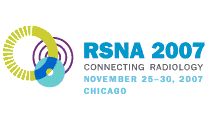
Abstract Archives of the RSNA, 2007
SSA15-03
Influence of Lung Nodule Characteristics on Computer-aided Detection (CAD) Based on the Lung Imaging Database Consortium (LIDC) CT Dataset
Scientific Papers
Presented on November 25, 2007
Presented as part of SSA15: Physics (Thoracic CAD )
David Andrew Olsen MS, Presenter: Nothing to Disclose
Justus E. Roos MD, Abstract Co-Author: Nothing to Disclose
David Seungwon Paik PhD, Abstract Co-Author: Spouse is consultant, 23andMe, Inc
Sandy Napel PhD, Abstract Co-Author: Medical Advisory Board, Fovia, Inc
Medical Advisory Board, Vital Images, Inc
Stockholder, Hologic, Inc
Stockholder, General Electric Company
Geoffrey D. Rubin MD, Abstract Co-Author: Speaker, Bracco Group
To investigate how nodule characteristics, as imaged by CT, influence CAD rankings using the LIDC dataset.
All 36 annotated chest MDCT scans with slice thickness ≤ 2mm from the LIDC dataset were used to test an experimental CAD system. This dataset contained 167 marked nodules (85 ≥ 3 mm). Each scan contained an un-blinded reading by four radiologists, consisting of full nodule outlines and reader-assigned characteristics (subtlety, sphericity, margin, lobulation, spiculation, texture, and likelihood of malignancy) for all nodules ≥ 3 mm. Reader agreement was measured by center of mass proximity and nodule size was calculated from nodule outlines. The CAD system consisted of lung segmentation, a primary detector, false positive reduction, and a trained final stage support vector machine classifier. The CAD outputs were ranked reflecting the likelihood of the detection to be a nodule. CAD was trained on a different set of 20 non-LIDC chest MDCT scans with 378 non-calcified and calcified nodules (216 ≥ 3 mm), using a reference standard established by two experienced thoracic radiologists in consensus. The CAD score was reduced to an ordinal confidence and a chi-squared test for trend was calculated for each characteristic.
The CAD system detected 71% (60) ≥3 mm nodules at 3.9 FP/Pt and 91% (77) ≥3 mm nodules overall. CAD rankings were significantly associated with reader agreement (p < 0.01), nodule texture (higher confidence for solid than GGO) (p < 0.001), and nodule margin (higher confidence for more sharply defined margins) (p < 0.0001). Sphericity, lobulation, spiculation, and likelihood of malignancy were not significantly associated with CAD ranking.
Our CAD method tends to rank nodules detected by multiple readers relatively high, and appears to be more sensitive to solid nodules with well-defined margins. This suggests that CAD could be improved with attention to GGOs and small amorphous opacities.
The LIDC dataset presents a unique opportunity for CAD designers to understand the influence of morphological characteristics when designing CAD systems.
Olsen, D,
Roos, J,
Paik, D,
Napel, S,
Rubin, G,
Influence of Lung Nodule Characteristics on Computer-aided Detection (CAD) Based on the Lung Imaging Database Consortium (LIDC) CT Dataset. Radiological Society of North America 2007 Scientific Assembly and Annual Meeting, November 25 - November 30, 2007 ,Chicago IL.
http://archive.rsna.org/2007/5014189.html

